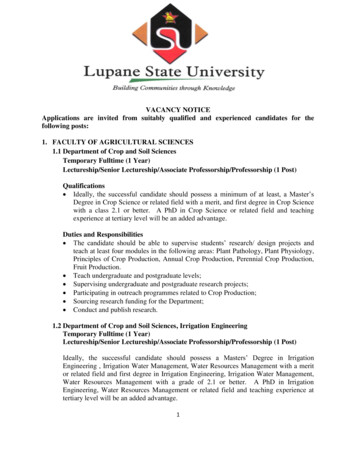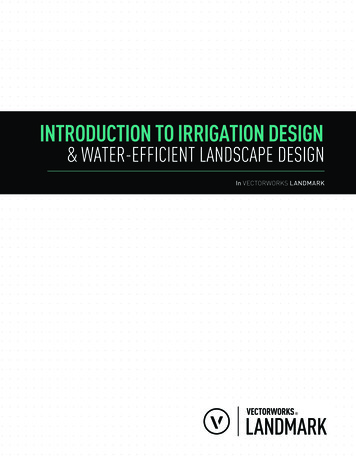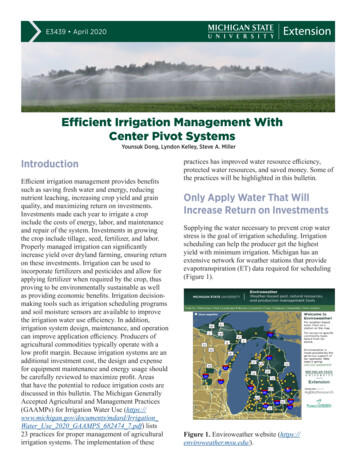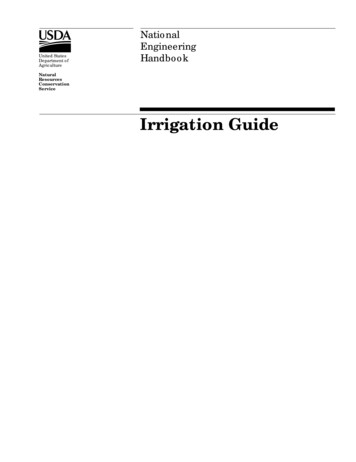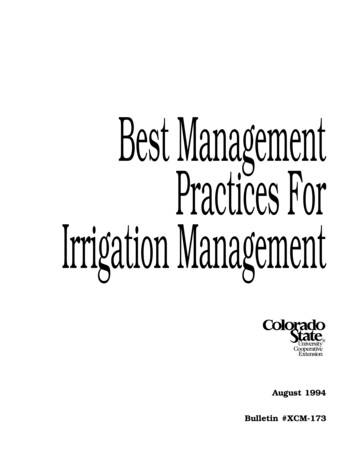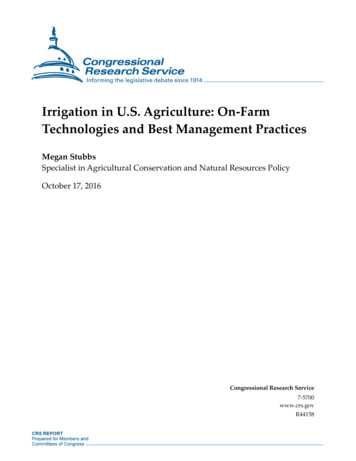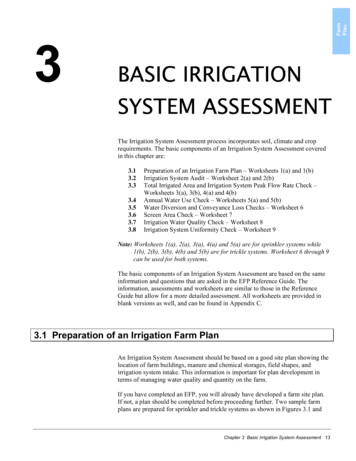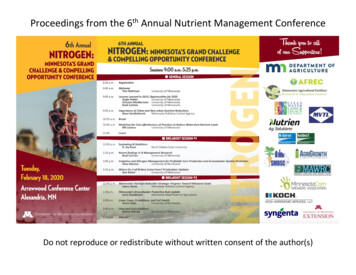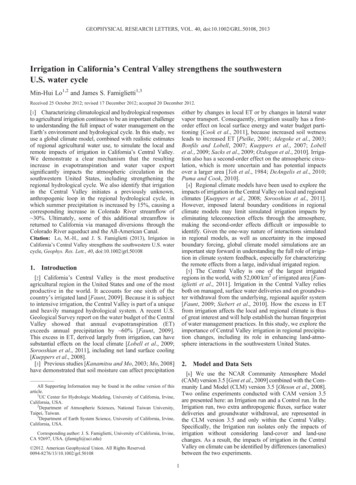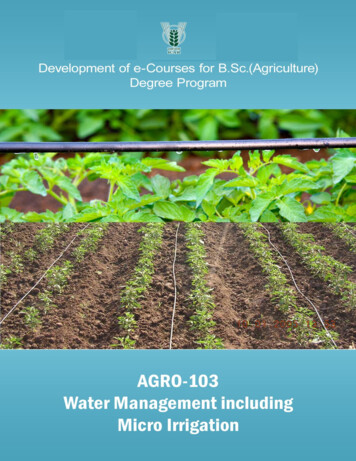
Transcription
Water Management including MicroIrrigationThis eCourse Developed ByTNAU (ICAR)
IndexsnLecturePage No1DEVELOPMENT OF IRRIGATION IN INDIA - WATERRESOURCES, IRRIGATION POTENTIAL AND IRRIGATIONSYSTEMS OF INDIA1-1223ROLE OF WATER IN PLANT GROWTH –HYDROLOGICAL CYCLE - WATER IN SOIL - PLANT ATMOSPHERE CONTINUUM - ABSORPTION OF WATERAND EVAPOTRANSPIRATIONSOIL WATER MOVEMENT - SATURATED ANDUNSATURATED FLOW AND VAPOUR MOVEMENT - SOILMOISTURE CONSTANTS AND THEIR IMPORTANCE INIRRIGATION13-2122-324SOIL MOISTURE MEASUREMENT33-415MOISTURE EXTRACTION PATTERN OF CROPS- SOILMOISTURE STRESS - PLANT WATER STRESS -EFFECTSON CROP GROWTH42-48CROP WATER REQUIREMENT - POTENTIALEVAPOTRANSPIRATION (PET) AND CONSUMPTIVE USEFACTORS AFFECTING CROP WATER REQUIREMENT CRITICAL STAGES – WATER REQUIREMENT OFDIFFERENT CROPS49-5667WATER requirement for different crops: Irrigationschedules for field crops57-608WATER BUDGETING AND ITS IMPORTANCE IRRIGATION SCHEDULING - APPROACHES61-769WATER USE EFFICIENCY (WUE) & INDICES77-8310 AGRONOMIC PRACTICES FOR USE OF PROBLEMWATER - SALINE, EFFLUENT, SEWAGE WATER84-8711 WATER MANAGEMENT FOR PROBLEM SOILS88-9112 Water Management Technology Options for Non-RiceCrops92-99
13 COMMAND AREA DEVELOPMENT- CONTINGENT CROPPLAN IN MAJOR IRRIGATION PROJECTS OF TAMILNADU - DRAINAGE – IMPORTANCE AND METHODS100-10314 WATER LOGGING AND FIELD DRAINAGE104-11115 DRIP IRRIGATION AND FERTIGATION112-13116 SPRINKLER IRRIGATION132-14417 PLASTIC MULCHING FOR CROP PRODUCTION145-16018 METHODS OF IRRIGATION - SUITABILITY, ADVANTAGESAND LIMITATIONS161-184
Water Management including Micro Irrigation01. DEVELOPMENT OF IRRIGATION IN INDIA - WATER RESOURCES,IRRIGATION POTENTIAL AND IRRIGATION SYSTEMS OFINDIA AND TAMIL NADUIMPORTANCE OF IRRIGATION MANAGEMENTIrrigationSimply, irrigation can be stated as application of water to the soil for crop growthand development. The application of water to plants is made naturally through rainfalland artificially through irrigation.Irrigation is defined as the artificial application of water to the soil for the purposeof crop growth or crop production in supplement to rainfall and ground watercontribution.ManagementRegulating, the activities based on the various resources for its efficient use andbetter out put. i.e., allocation of all the resources for maximum benefit and to achieve theobjectives, without eroding the environment is called management. Otherwise it can bestated as planning, executing, monitoring, evaluating and re-organizing the wholeactivities to achieve the target.Irrigation ManagementManagement of water based on the soil and crop environment to obtain betteryield by efficient use of water without any damage to the environment.Management of water, soil, plants, irrigation structure, irrigation reservoirs,environment, social setup and it’s inter liked relationship are studied in the irrigationmanagement.For this we have to study The soil physical and chemical properties Biology of crop plants Quantity of water available Time of application of waterwww.AgriMoon.Com
Water Management including Micro Irrigation Method of application of water Climatological or meteorological influence on irrigation and Environment and its changes due to irrigationManagement of all the above said factors constitute Irrigation Agronomy:Management of irrigation structures, conveyances, reservoirs constitute IrrigationEngineering; and social setup, activities, standard of living, irrigation policies, irrigationassociation and farmer’s participation, cost of irrigation etc., constitute Socio-economicstudy.Except Economics and Engineering all the other components are grouped underAgronomy.Sociology has a major role in irrigation management in a large system.Hence Engineering, Economics, Social science and Agronomy are the major facultiescome under Irrigation Management.Irrigation management is a complex process of art and science involvingapplication of water from source to crop field. The source may be a river or a well or acanal or a tank or a lake or a pond.Maintaining the irrigation channels without leakage and weed infestation,applying water to field by putting some local check structure like field inlet andboundaries for the area to be irrigated etc., need some skill. These practices are the artinvolving practices in irrigation management.Time of irrigation and quantity of water to be applied (when to irrigate? and howmuch to irrigate?) based on soil types, climatic parameters, crop, varieties, growth stages,season, quality of water, uptake pattern of water by plants, etc., and method of application(How best to irrigate) includes conveyance of water without seepage and percolationlosses and water movement in soil, are the process involving scientific irrigationmanagement.Simply, it is a systematic approach of art and science involved in soil, plant andwater by proper management of the resources (soil, plant and water) to achieve the goalof crop production.Importance of Irrigation management2www.AgriMoon.Com
Water Management including Micro IrrigationWater is essential not only to meet agricultural needs but also for industrialpurposes, power generation, live stock maintenance, rural and domestic needs etc. Butthe resource is limited and cannot be created as we require.Hence irrigationmanagement it very important: To the development of nation through proper management of water resources forthe purpose of crop production and other activities such as industrialization,power generation etc., which in turn provides employment opportunities and goodliving condition of the people. To store the regulate the water resources for further use or non-season use To allocate the water with proper proportion based on area and crop undercultivation. (Balanced equity in distribution) To convey the water without much loss through percolation and seepage(Efficiency in use) To apply sufficient quantity to field crops. (Optimization of use) To utilize the water considering cost-benefit (Economically viable management) To distribute the available water without any social problem (Judicial distribution) To meet the future requirement for other purposes like domestic use of individualand to protect against famine (Resource conservation). To protect the environment from over use or misuse of water (Environment safeuse).Impact of excess and insufficient irrigation water in cropsAvoid excess or insufficient water to the cropsExcess irrigation leads to wastage of large amount of water, leaching of plantnutrients, destruction of beneficial microbes, increase of expenses on drainage,accumulation of salt leading to salinity and alkalinity, water logging leading tophysiological stress and yield loss or crop failure.Insufficient irrigation leads to reduction in quality of food grains, loss in cropyield or crop failure, poor soil environment etc.3www.AgriMoon.Com
Water Management including Micro IrrigationWater becomes a limiting resource due to the multi-various demand from sectorslike agriculture, livestock, industries, power generation and increased urban and ruraldomestic use. The increasing population increases the needs of industrial complexes andurbanization to meet the basic requirement and also to provide employment opportunities.So the demand for water is increasing day by day and hence, it is essential to study waterpotential and its contribution to agriculture which is turn is going to feed the growingpopulation.Sources of waterRainfall is the ultimate source of all kind of water.Based on its sources ofavailability it can be classified as surface water and subsurface water.Surface water includes precipitation (including rainfall and dew) water availablefrom river, tank, pond; Lake Etc., Besides, snowfall could able to contribute somequantity of water in heavy snowfall area like Jammu, Kashmir and Himalaya regin.Subsurface water includes subsurface water contribution, underground water,well water etc.Rain fallSeasons of rainfall can be classified s follows1. Winter (Cold dry period-January – February2. Summer (Hot weather period-March – May3. Kharif (South-West monsoon)-June – September4. Rabi (North-East monsoon)-October – DecemberSouth-west monsoonIt comprises the month June, July, August and September which contributes about70% of rainfall to India except for extreme North of Jammu and Kashmir and extremesSouth of Tamil Nadu. Hence the success of agriculture in India depends on timely onset,adequate amount and even distribution of this South West Monsoon (SWM). This seasonis also called as Kharif season.North East monsoon4www.AgriMoon.Com
Water Management including Micro IrrigationIt comprises the months of October, November and December.North EastMonsoon (NEM) contributed rainfall to South Eastern part of peninsular India TamilNadu receives its 60% of rainfall from NEM (North East Monsoon). This season is alsocalled as Rabi season.WinterIt comprises of the month of January and February.It contributes very littlerainfall.SummerComprises of the months of March, April and May and contributes little summershowers.Characteristics of good rainfall1. Quantity should be sufficient to replace the moisture depleted from the root zone.2. Frequency should be so as to maintain the crop without any water stress before itstarts to wilt.3. Intensity should be low enough to suit the soil absorption capacity.Indian rainfall does not have the above good characteristics to maintain the cropthrough rainfall alone.Characteristic features of Indian rainfall Annual Average rainfall is 1190 mm There is wide variation in the quantity of rainfall received from place to place.Highly erratic, undependable, variation in seasonal rainfall either in excess ordeficit are the nature of Indian rainfall. For example a place in Rajasthan receivespractically nil rainfall at the same time Chirapunji about 3000 mm rainfall. Rainfall is not uniformly distributed throughout the year. It is seasonal, majorquantity is in the South West Monsoon, (SWM alone contributing 70% of totalrainfall) i.e. in the month of June to September followed by North East Monsoon(NEM) from October to December. It summer and winter the amount of rainfallis very little.5www.AgriMoon.Com
Water Management including Micro Irrigation With in the season also the distribution is not uniform. A sudden heavy downpourfollowed by dry spell for a long period is common occurrence. Rainfall distribution over a large number of days is more effective than heavydown pour in a short period, but it is in negative trend in India Late starting of seasonal monsoon Early withdrawal of monsoon and Liability to failure are the freakish behaviour of Indian rainfall.Timely anduniform distribution of rainfall is important for better crop planning and to sustaincrop production.IRRIGATION – HISTORY AND STATISTICSIrrigation has been practiced since time immemorial, nobody knows when it wasstarted but evidences say that it is the foundation for all civilization since greatcivilization were started in the river basins of Sind and Nile.This civilization came to an end when the irrigation system failed to maintaincrop production.There are some evidences that during the Vedic period (400 B.C) people used toirrigate their crops with dug well water. Irrigation was gradually developed and extendedduring the Hindus, Muslims and British periods.The Grand Anaicat (KALLANAI) constructed across the river Cauvery is anoutstanding example for the irrigation work by a Chola king the great Karikala Cholanduring second century. The Veeranarayanan Tank and Gangai Konda Cholapuram tankwas constructed during 10th century in TN. Anantaraja Sagar in AP was constructedduring 13th century.Early Mauryan king Samudragupta and Ashoka took great interest in theconstruction of wells and tanks. Later Moghul kings or North India and Hindu kings ofSouth India focused their attention, in the establishment of canals, dams, tanks etc.British Government initiated their work during 19th century in remodeling andrenovation of the existing irrigation system.6The Upper Ganga canal, Krishna andwww.AgriMoon.Com
Water Management including Micro IrrigationGodaveri delta system, Mettur and Periyar dams are the great irrigation structures built bythe British rulers. After independence, Irrigation activities have been accelerated andnumber of multipurpose river valley projects like Bhakrea-nangal in Punjab,Tungabhadra in Andraprdesh, Damodar Valley in Madya Pradesh were established.Irrigation Development during five year plansIn 1950 – 51 the gross irrigated area was 22.5 million ha. After completion of 1five year plan the gross irrigated area was enlarged to 26.2 million ha. Further it wasgradually increased to 29, 35.5, 44.2, 53.5; 75 million has respectively over the II, III, IV,V, VI & VII five years plans. The expected increase through VIII and IX five year plansarea 95 and 105 m ha respectively.Classification of irrigation work or projectsThe irrigation projects can be classified as 1. major 2. medium 3. minor based onfinancial limits or expenditure involved in the scheme.1. Major – more than 50 million Rupees : It covers cultural command area of morethan 10,000 hectares2. Medium – 2.5 million to 50 million Rupees : It covers cultural command area of2000 – 10,000 hectares3. Minor – less than 2.5 million Rupees : It covers cultural command area of 2,000hectares.The minor irrigation work consists of irrigation tanks, canals and diversion workfor the welfare of small of farmers.Indian has may perennial and seasonal rivers which flow from outside and withinthe country. Among this some important rivers of different states are given below.Important irrigation projects in IndiaStateA.P.Project NameGodavari delta system, Krishna delta system, Nagarjuna sagarBihar(Krishna)Gandala7www.AgriMoon.Com
Water Management including Micro kaOrissaU.PW.BRajasthanTamil NaduWestern Jamuna, Bhakranangal Sutlej, BeasKakrapare – Tapti NarmadaGandhi sagar (Chambal, Ranap setab, sagarBhima Jayakwadi (Godavari)Kalada, Mullai PeriyarGhataprabha, Malaprapha and TurgaHirkand and mahanathiUpper ganga canal, RamagangaDamodar ValleyRajasthan Canal (Sutlej)Mettur – Lower Bhavani ProjectParambikulam Alliyar ProjectPeriyar Vaigai, Cauvery deltaTamiarabarani, Other river basins in TN is given in MapIndia’s water budgetTotal geographical area 328M.ha.Average annual rainfall 1190mmIn million hectare metre 1190 x 328 392 M ha mContribution from snowfall 8 M ha mTotal 400 m ha m.The rainfall below 2.5 mm is not considered for water budgeting, since it willimmediately evaporate from surface soil without any contribution to surface water orground water.When rainfall occurs, a portion of it immediately evaporates from the ground ortranspires from vegetation, a portion infiltrates into the soil and the rest flows oversurface as run off.There are on an average 130 rainy days in a year in the country out of which therain during 75 days considered as effective rain. The remaining 55 days are very lightand shallow which evaporates immediately without any contribution to surface or groundwater recharge.Considering all these factors it is estimated that out of 400 million8www.AgriMoon.Com
Water Management including Micro Irrigationhectare meter of annual rainfall 70 million hectare meter is lost to atmosphere throughevaporation and transpiration, about 115 million hectare meter flows as surface run-offand remaining 215 million hectare meter soaks or infiltrates into the soil profileSurface run-offSurface run off consists of direct run off from rainfall, melting of snowfall andflow in streams generated from ground water. Total surface run-off has been estimatedby Irrigation Commission of India in 1972 as follows.a) Total surface run off180 M ha mb) Rain fall contribution115 M ha mc) Contribution from outside the country through steams and rivers20 M ha md) Contribution from regeneration from ground water in Stream and rivers 45 M ha mTotal180 M ha mDisposal of surface run offThe surface runoff is disposed in three ways1. Stored in reservoirs2. Disappears by means of percolation, seepage and evaporation3. Goes to sea as wasteThe waster stored in reservoirs is lost through evaporation and some amountthrough seepage.The rest in utilized for various purposes mainly for irrigation anddrinking water.Total surface run off 180 M ha mStored in reservoir and tanks 15 M ha mFlow in the river 165 M ha mUtilization from the river by diversion tank and direct pumping 15 M ha mWater goes to sea as waste 150 M ha mOn full development work expected utilization 45 M ha mWater flows to sea 105 M ha m9www.AgriMoon.Com
Water Management including Micro IrrigationLand utilization pattern of IndiaTotal geographical area 328.00 M haNet area reported 307.47 M haArea under forest 65.90 M haArea under non agricultural use, barren and uncultivable waste 100. 45 M haNet Area sown 141.12 M haNet area irrigated 31.20 M haGross area sown 164.00 M haGross area irrigated 80.50 M haLand utilization pattern in Tamil NaduTotal geographical area 13.00 M haArea under forest 2.00 M haNon agricultural area 1.40 M haBarren and uncultivated 0.80 M haPastures 0.20 M haTree 0.20 M haCulturable waste 0.50 M haCulturable fallow 0.90 M haOther fallow 0.50 M haGross area under cultivation 7.30 M haNet area sown 6.30 M haGross area irrigated 3.50 M haNet area irrigated 2.70 M haTamil Nadu Ground Water PotentialAverage rainfall 850 mmGround water potential 36872 Mm3G. water utilization 19,801 Mm310www.AgriMoon.Com
Water Management including Micro IrrigationUnutilized 46.3%Percentage of area depends upon ground water in various parts of Tami NaduSalem 83%Dharmapuri 65.3%Coimbatore 51.3%Madurai 45.1%Trichy 34.9%Tirunelveli 35.0%Water Resources in India and Tamil NaduDistribution of irrigated area in ‘000 hectaresIndiaTamil 2,60135World Irrigation StatisticsSl.No.1234567891011121314CountriesArea irrigated in million IsraelJapanPakistan11www.AgriMoon.Com
Water Management including Micro .AgriMoon.Com
Water Management including Micro Irrigation02. ROLE OF WATER IN PLANT GROWTH – HYDROLOGICAL CYCLE WATER IN SOIL - PLANT - ATMOSPHERE CONTINUUM ABSORPTION OF WATER AND EVAPOTRANSPIRATIONIMPORTANCE OF WATER – THE LIQUID GOLDPlants and any from of living organisms cannot live without water, since water isthe most important constituent about 80 to 90% of most plant cell.Role of water in crop and crop production can be grouped asA) Physiological importance The plant system itself contains about 90% of water Amount of water varies in different parts of plant as follows Apical portion of root and shoot 90% Stem, leaves and fruits- 70 - 90% Woods- 50 - 60% Matured parts- 15 - 20% Freshly harvested grains- 15 - 20% It acts as base material for all metabolic activities. All metabolic or biochemicalreactions in plant system need water. It plays an important role in respiration and transpiration It plays an important role in photosynthesis It activates germination and plays in important role in plant metabolism forvegetative and reproductive growth It serves as a solvent in soil for plant nutrients It also acts as a carrier of plant nutrients from soil to plant system It maintains plant temperature through transpiration It helps to keep the plant erect by maintaining plant’s turgidity It helps to transport metabolites from source to sinkB) Ecological Importance It helps to maintain soil temperature13www.AgriMoon.Com
Water Management including Micro Irrigation It helps to maintain salt balance It reduces salinity and alkalinity It influences weed growth It influences atmospheric weather It helps the beneficial microbes It influences the pest and diseases It supports human and animal life It helps for land preparation like ploughing, puddling, etc., It helps to increase the efficiency of cultural operations like weeding, fertilizerapplication etc., by providing optimum condition.The multifarious uses of good quality water for the purpose of irrigation,industrial purposes, power generation, livestock use, domestic use for urban and ruraldevelopment, are increasing the demand for water. Due to increasing cost of irrigationprojects and limited supply of good quality water, it becomes high valuable commodityand hence it is stated as Liquid Gold.Further, historical evidences indicate that allcivilization established on water base due to proper management and disappear due toimproper management of the same water base. All the superior varieties, organic manure,inorganic fertilizer, efficient labour saving implements, better pest and diseasemanagement techniques can be implemented only when sufficient water is applied to thecrop. The diversified value of water can be quoted as follows:Water as a source of sustenanceWater as an instrument of agricultureWater as a community goodWater as mean of transportationWater as an industrial commodityWater as a clean and pure resourceWater as a beauty14www.AgriMoon.Com
Water Management including Micro IrrigationWater as a destructive force to be controlledWater as a fuel for urban developmentWater as place for recreation and wild life habitatAs indicated by Sir.C.V.Raman water is the ELIXER of Life which makeswonders in earth if it is used Properly, Efficiently, Economically, Environmentally,Optimally, Equitably and Judicially.Hydrological CycleSolid – liquid- gaseous form (refer any standard book)State of water as solid – ice, its temperature – presence as ice, icebergs and IceMountains, ice glaciers and their role on water availabilityAs water – ocean – extent of ocean – their role on water availabilityGaseous form – clouds and their formation – precipitation – forms of precipitation etc.Water in Soil - plant - atmosphere continuumSoil physical properties influencing irrigationSoil is a three-phase system comprising of the solid phase made of mineral andorganic matter and various chemical compounds, the liquid phase called the soil moistureand the gaseous phase called the soil air. The main component of the solid phase is thesoil particles, the size and shape of which give rise to pore spaces of different geometry.These pore spaces are filled with water and air in varying proportions, depending on theamount of moisture present. The presence of solid particles, liquid (soil solution) and gas(soil air) constitute a complex polyphasic system. The volume composition of the threemain constituents in the soil system varies widely. A typical silt loam soil, for example,contains about 50 per cent solids, 30 per cent water and 20 per cent air. In addition to thethree basic components, soil usually contains numerous living organisms such asbacteria, fungi, algae, protozoa, insects and small animals which directly or indirectly15www.AgriMoon.Com
Water Management including Micro Irrigationaffect soil structure and plant growth. The most important soil properties influencingirrigation are its infiltration characteristics and water holding capacity.Other soilproperties such as soil texture, soil structure, capillary conductivity, soil profileconditions, and depth of water table are also given consideration in the management ofirrigation water.Water Relations of SoilThe mineral and organic compounds of soil from a solid (though not rigid) matrix,the interstices of which consists of irregularly shaped pores with a geometry defined bythe boundaries of the matrix (Fig. 7.5). The pore space, in general, is filled partly withsoil air and liquid vapour and partly with the liquid phase of soil water. Soil moisture isone of the most important ingredients of the soil. It is also one of its most dynamicproperties. Water affects intensely many physical and chemical reactions of the soil aswell as plant growth.The properties of water can be explained by the structure of its molecule. Twoatoms of hydrogen and one atom of oxygen combine to form a molelargely determinedby that of the oxygen ion. The two hydrogen ions take up practically no space. Watermolecules do not exist individually. The hydrogen in the water serves as a connectinglink from one molecule to the other.Soil serves as the storage reservoir for water. Only the water stored in the rootzone of a crop can be utilized by it for its transpiration and buildup of plant tissues.When ample water is in the root zone, plants can obtain their daily water requirements forproper growth and development. As the plants continue to use water, the available supplydiminishes, and unless more water is added, the plants stop growing and finally die.Before the stage is reached when crop growth is adversely affected, it is necessary to16www.AgriMoon.Com
Water Management including Micro Irrigationirrigate again. The amount of water to be applied to each irrigation, and the frequency ofirrigation are dependent on the properties of the soil and the crop to be irrigated.Kinds of soil water: When is added to a dry soil either by rain or irrigation, it isdistributed around the soil particles where it is held by adhesive and cohesive forces; itdisplaces air in the pore spaces and eventually fills the pores. When all the pores, largeand small, are filled, the soil is said to be saturated and is at its maximum retentivecapacity. The following re the three main classes of soil water:(i) Hygroscopic water.Water held tightly to the surface of soil particles byadsorption forces.(ii) Capillary water. Water held by forces of surface tension and continuous filmsaround soil particles and in the capillary spaces.(iii) Gravitational water. Water that moves freely in response to gravity and drainsout of the soil.Adhesion is the attraction of solid surfaces for water molecules. Adhesion isoperative only at the solid-liquid interface and hence the film of water established by it isvery thin. Cohesion is the attraction of water molecules for each other. This force makespossible a marked thickness of thefilms of water established byhydration until they attainmicroscopic size. As the film getsthicker and thicker the forces ofgravity act and water flowsdownward through the large pores.Such water is loosely held. Thus,when a soil is near saturation it iseasy to remove an increment ofwater, but as moisture becomes less17www.AgriMoon.Com
Water Management including Micro Irrigationand less in the soil, the greater will be the force required to remove a unit amount ofmoisture.When a dry soil samples is exposed to water vapour, it will take up moisture. Theamount adsorbed depends on the nature and magnitude of the surface exposed thetemperature and the degree of humidity. The moisture thus adsorbed is the water ofhydration, water of adhesion, or commonly the hygroscopic water.When the airsaturation is 100 per cent the maximum amount of such moisture will be acquired.The capillary water is held between tensions of about 31 atmospheres and onethird atmosphere. Between 31 and 15 atmospheres, capillary adjustment is very sluggish.Comparatively easy movement does not occur until the water film thickens and pressuresnear one-third atmosphere are reached. As a result of its energy relations, the capillarywater is the only fluid water bearing solutes, that remains in the soil for any length oftime, if drainage is satisfactory. Thus, it functions physically and chemically as the soilsolution. The principal factors influencing the amount of capillary water in soils are thestructure, texture and organic matter. The finger the texture of the mineral soil particles,the greater is likely its capillary capacity.Granular soil structure produces highercapillary capacity. Presence of organic matter increases the capillary capacity.Water held in the soil at tensions of one-third atmosphere or less will respond togravity and move downward, hence the name gravitational water.The water thusaffected is that present in the non-capillary (large) pores. Of the three forms of water,only capillary and gravitational water are of interest to the irrigationists since hygroscopicwater is not available to plants.Movement of water into soils: The movement of water from the surface into thesoil is called infiltration.The infiltration characteristics of the soil are one of thedominant variables influencing irrigation.Infiltration rate is the soil characteristicdetermining the maximum rate at which water can enter the soil under specificconditions, including the presence of excess water. It has the dimensions of velocity.18www.AgriMoon.Com
Water Management including Micro IrrigationThe actual rate at which water is entering the soil at any given time is termed theInfiltration velocity.The infiltration rate decreases during irrigation. The rate of decrease is rapidinitially and the infiltration rate tends to approach a constant value. The nearly constantrate that develops after some time has elapsed from the start of irrigation is called thebasic infiltration rate.Factors Affecting Infiltration RateThe major factors affecting the infiltration of water into the soil are the initialmoisture content, condition of the soil surface, hydraulic conductivity of the soil profile,texture, porosity, and degree of swelling of soil colloids and organic matter, vegetativecover, duration of irrigation or rainfall and viscosity of water.The antecedent soilmoisture content has considerable influence on the initial rate and total amount ofinfiltration, both decreasing as the soil moisture content rises. The infiltration rate of anysoil is limited by any restraint to the flow of water into and through the soil profile. Thesoil layer with the lowest permeability, eith
Agronomy. Sociology has a major role in irrigation management in a large system. Hence Engineering, Economics, Social science and Agronomy are the major faculties come under Irrigation Management. Irrigation management is a complex process of art and science involving application of water from source to crop field.
